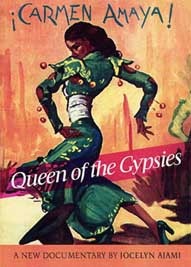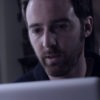
Dancing Queen
Written by Amy Souza | Posted by: Anonymous
Sometimes what’s waiting on the other side of the bridge from Boston to Cambridge may be well worth the short trip. Just ask Jocelyn Ajami. One night, she was sitting in a Boston café with a friend who suggested they head to Cambridge to watch a flamenco dancer. "I didn’t want to go," she said. "I went kicking and screaming. You know, it’s all the way over the bridge."
Watching the electrifying performance by Omayra Amaya, Ajami realized she had found the subject for her next film. "I realize now that I no longer pick the topics of my film. They pick me," she says.
Having already made two films that tackled tough subjects — "Jihad" and "Oasis of Peace" — Ajami assumed she would continue her film career by pursuing another socially conscious topic. Instead, she followed Omayra Amaya for three years to produce "Gypsy Heart." Though Ajami was born in Venezuela and had heard about flamenco all her life, she says she didn’t really know the dance’s origins or much about the culture surrounding it. "I only knew flamenco the way an American might know about gospel," she says. "I’d heard of it, but I didn’t really know what it meant."
The making of "Gypsy Heart" led Ajami to her most recent project, "Queen of the Gypsies," a biography of Omayra’s great aunt, Carmen Amaya, a world-famous flamenco dancer until her death in 1963.
"Queen of the Gypsies" tells the story of Carmen Amaya’s life, but also provides a glimpse into Gypsy culture. Born in Barcelona in 1913, Carmen began dancing flamenco as a child. She gew to become an international phenomenon, starring in Hollywood movies, touring the world, and dancing in the Roosevelt White House. She was renowned for her ability to dance all the different rhythms of flamenco, whereas most dancers specialized in just one rhythm. She also adopted the footwork of male flamenco dancers, thus creating her own style.
The depth of Ajami’s research is apparent in the "Queen of the Gypsies." "Research is very important to me," Ajami says. When starting a project she first looks to a bibliography on the subject, reading everything she can find, and searches for the experts and primary sources. For this film, Ajami met with teachers and practitioners, interviewed flamencologists and historians, and attended performances. "It’s like if you’re a painter, you go to the museum and look at paintings." She also took flamenco classes, though she says she never made it out of the beginner’s course.r
Having access to the Amaya family proved crucial to the project’s success, and she interviewed a number of people who danced or played music with Carmen Amaya. "The Amayas have become like family," she says, though at first there was some nervousness on their part. "In Gypsy culture, there’s always the fear of being misrepresented."
The story is told through interviews and visuals, without any narration. Ajami, who speaks five languages, conducted interviews in Spanish, French, and English. But interviews wouldn’t have been enough to sustain the story. Ajami spent years securing the rights to archival film footage of Carmen dancing, which adds an excitement and exhilaration to the film. Much of the footage came from Carmen’s Hollywood films and Ajami says she got access to it through "great difficulty and tears."
"Basically I wrote Universal and MGM for five years, not leaving them alone," she says. She finally got them to lower their usual fee of $7,000 a minute to $3,000 a minute for all markets, still expensive for an independent documentary but cheap by Hollywood standards.
Ajami discovered another sequence of archival footage by accident. "I was sitting in a café in New York and I saw a man having tomato on bread," Ajami says. "I thought, he must be from Barcelona, but I was too tired to go over and speak to him. The next day he was there with his wife and I approached them."
It turned out that the couple knew Carmen Amaya and some of her friends. That serendipitous meeting led Ajami to a man who owned a home in Baruga, where Carmen Amaya lived and died, who let Ajami use footage he had shot of Carmen’s funeral procession.
As difficult as it was to gather archival footage, Ajami says the biggest challenge in making "Queen of the Gypsies" was something that people don’t even notice: structuring the story. Ajami whittled down her 100 hours of footage and initial 600-page script to 80 minutes and 40 pages. "I’m pretty proud of it," she says. "I had 12 to 17 themes to weave together. I wanted to inform but I also wanted to create a human interest story."
Switching Mediums
Ajami was drawn to filmmaking 10 years ago by her curiosity and interest in many different subjects. An acclaimed abstract painter, Ajami grew to dislike the actual process of painting. As the Gulf War began, she also felt frustrated at the misuse of the word "jihad"
"I knew what ‘jihad’ meant and it didn’t mean ‘Holy War,’" she says. "That propelled me to make my first film."
Ajami interviewed a number of Muslim leaders in New England and ended up with a 10-minute video titled simply, "Jihad." At its lowest meaning, jihad means a struggle to be pious, she says. A jihad of the self, then, is the struggle to get up each morning and go to work, a struggle to lead a moral life.
"A jihad of self-defense is that, without compulsion, you should defend yourself if attacked," she says. "So Saddam’s war was really anti-Islamic and any of the Muslim leaders will tell you that."
After "Jihad" Ajami made the film "Oasis of Peace," about a village where Jews and Palestinians live together, in what she describes as "active coexistence" for nearly 25 years.
Each of her films takes three to four years to complete, and Ajami tries to work simultaneously on fundraising and research. She’ll also go out and shoot, if necessary, before securing funding. "Your time is your own, really, so if there’s something to shoot, you might as well," she says.
Like many independent filmmakers, Ajami works alone during pre-production and production. "It’s great if you can get an intern to help you," she says, "but that’s not always possible." Thus, she ends up spending more time than she’d like at the copy shop, and shooting all her interviews herself. She shot "Queen of the Gypsies" on her Sony VX1000 camera. "When I have a little tiny bit of control I can compose beautifully. But give me really bad circumstances and forget it. But I learn things every single time."
She’s not a huge fan of her VX1000, though, and would much prefer to use her lower-end Hi-8 camera. "I think superior cameras are awful in inferior circumstances," she says. Her biggest challenge producing "Queen of the Gypsies" came in the form of a two-person interview during which she had to monitor the camera, act as interviewer, and deal with the mixer and two microphones. She had never met the couple before and they wanted to converse with her while she was trying to set their mic levels. The end result doesn’t detract from the film, but Ajami says that’s because she and editor Joshua Antell spent a lot of time cleaning up the shots.
The self-described director-producer-chief bottle washer doesn’t take a salary from her films. Rather, she makes her living teaching art and speaking for a fee. Her speaking engagements, on topics like Conflict and Peace and Modernism and Abstract Art, have led to financial help for future films, and she suggests that other aspiring documentary filmmakers speak in public on topics they’re knowledgeable about.
"People see that I know something and I get noticed," she says. "Even if you speak for free, if you share your expertise, people will notice you."
"It’s really networking by default," she continues. "I’m not Networking Nancy. I think it’s so artificial, and I don’t think it works anyway."
Ajami moved to Boston twenty years ago to be close to her family. She finds the area film community very supportive and is especially enamored of the Museum of Fine Arts, in part because filmmakers need not have an extensive resume to get their work shown there and because the film program features films from around the world that aren’t being shown in other venues. "I think Bo Smith is a hero," she says of the man who runs the MFA’s film program. "I think the MFA is the best outlet for independents in the country. They even give you a percentage of the ticket sales. Nobody else does that."
'Queen of the Gypsies' is playing at the Remis Auditorium, Museum of Fine Arts on Sunday, December 8th, at 4 p.m.; Wednesday, December 18th, at 6 p.m.; and Saturday, December 21st, at 10:30 a.m. It will also be shown in New York, at the Walter Reade Theater, Lincoln Center on January 10 at 1 p.m. and January 18 at 3:30 p.m. For more information or to purchase a video, visit www.gypsyheartproductions.com.










